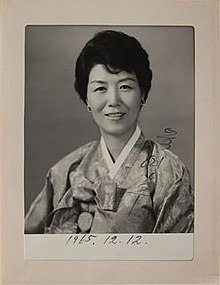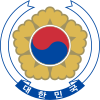
Yuk Young-soo
Yuk Young-soo | |
|---|---|
| 육영수 | |
 Official portrait Yuk Young-soo | |
| First Lady of South Korea | |
| In role 24 March 1962 – 15 August 1974 Acting until 17 December 1963 | |
| President | Park Chung Hee |
| Preceded by | Gong Deok-gwi |
| Succeeded by | Park Geun-hye (acting) |
| Personal details | |
| Born | 29 November 1925 Okcheon County, Chūseihoku-dō (North Chungcheong Province), Korea, Empire of Japan |
| Died | 15 August 1974 (aged 48) Seoul, South Korea |
| Manner of death | Assassination by gunshot |
| Resting place | Seoul National Cemetery |
| Spouse | |
| Children | Park Geun-hye Park Geun-ryoung Park Ji-man |
| Education | Baehwa Women's High School |
| Korean name | |
| Hangul | 육영수 |
|---|---|
| Hanja | |
| Revised Romanization | Yuk Yeong-su |
| McCune–Reischauer | Yuk Yŏngsu |
Yuk Young-soo (Korean: 육영수; Korean pronunciation: [juɡjʌŋsʰu]; 29 November 1925 – 15 August 1974) was the wife of the 3rd South Korean president Park Chung Hee and the mother of the 11th South Korean president Park Geun-hye. She was the first lady when Park was in office, from 1962 until her assassination in 1974 during an attempted assassination of her husband.

Early life
Yuk was born in Okcheon County, North Chungcheong Province, Korea in 1925, the second of three daughters of a prosperous self-made landlord. She graduated from Baehwa High School for Girls (presently known as Paihwa Girls' High School). In August 1950 she met Park Chung Hee through a relative who was serving under Park.[1] On 12 December 1950 she married Park Chung Hee. While her mother supported her choice of husband, Yuk's father was against the match, so she married without his blessing.[2]

First Lady

When Park Chung Hee was in the mission as the chairman of the Supreme Council for National Reconstruction, Yuk Young-soo's main interest was handling civil complaints. Jeong Jae-hoon, a disciple and secretary of the First Lady's Office for six years, recalled:[3]

"We have conversations with as many people as possible to collect public opinion on the streets, and dozens of complaints a day are left with instructions. I made them run."
Yuk Young-soo always made a simple impression on people regarding Hanbok and elegance, and was a sincere wife to her husband at home. She also took great interest in children and health, and often visited orphanages and nurseries several times to develop policies for children's health. During her husband's tenure, she mainly took care of receiving guests and dealing with complaints, although she wanted to do her part as "a revolutionary's wife". She was also involved with the Red Cross and with children with autism. In 1970, the construction of Children's Grand Park started and opened the following year.[4]

She was also close to the people, and visited patients suffering from leprosy. She helped to start several self-support projects, and visited the families of South Korean soldiers deployed to Vietnam, to comfort and console them. In 1973, she undertook projects which saw the development of vocational training institutes for poor and disadvantaged youth. Because of the efforts of Yuk Young-soo, a vigorous social services are professional because the social welfare-oriented vocational training that have had to know glim of poverty.[5]

She also did not hesitate to try to influence her husband, especially in 1963, when, to resolve tensions with the American ambassador Samuel D. Berger, she invited him to the Blue House. Park Chung Hee then joked about it, going so far as to consider her "the first opposition party". In 1969, she created a private foundation with the aim of improving the well-being of South Korean children. In 1974, a mother was invited to the Blue House revealed that her child was suffering from facial paralysis. Yuk Young-soo found the best acupuncture center and hospitalized him.[6]

Death
At 10:23 a.m., 15 August 1974,[7] South Korean Independence Day, Yuk was gunned down by Mun Se-gwang, a Zainichi Korean and North Korean sympathizer, during an attempt by Mun to assassinate President Park Chung Hee.[8]


The assassination occurred at the Seoul National Theater of Korea during an Independence Day ceremony. Mun intended to shoot Park in the theater lobby. However, his view was obstructed, and he was forced to enter and be seated near the back of the theater. During Park's address, he attempted to get closer to the President but inadvertently fired his Smith & Wesson Model 36 revolver prematurely, injuring himself. Having alerted security, he then ran down the theater aisle firing wildly.[9] His second bullet hit the left side of the podium from which Park was delivering his speech. The third bullet was a misfire. His fourth bullet struck Yuk Young-soo in the head, seriously wounding her. His last bullet went through a flag decorating the rear of the stage. A bullet fired by Park Jong-gyu, a member of the President's security detail, in response to Mun's attack, ricocheted off a wall and killed a high school student, Jang Bong-hwa. Immediately following the capture of Mun, Park resumed his scheduled speech despite his wife being wounded and carried from the stage. Following its completion he picked up his wife's handbag and shoes and left.[10]

Yuk was rushed to the Seoul National University Hospital in Wonnam-dong, central Seoul. Dr. Shim Bo-seong, who was chief of the hospital's neurosurgery department, began operating on Yuk at 11 a.m., which lasted for over five hours. The bullet damaged the largest vein on the right side of her brain and remained lodged within the brain. The surgery was unable to save her life and she died at 7:00 p.m. that same day.[11]

Aftermath

Yuk was buried in a state funeral on 19 August 1974 at Seoul National Cemetery.[12] After the assassination of Park Chung Hee, he was buried next to her. Park composed the following poem the day after Yuk's state funeral.[13]

Like a Long Magnolia Blossom Bending to the Wind
Under heavy silence
Of a house in mourning
Only the cry of cicadas
Ma'am, ma'am, ma'am
Seem to long for you who is now gone
Under the August sun
The Indian Lilacs turn crimson
As if trying to heal the wounds of the mind
My wife has departed alone
Only I am left
Like a lone magnolia blossom bending to the wind
Where can I appeal
The sadness of a broken heart

Park Geun-hye then became the First Lady of South Korea, after returning urgently from her studies in France at the Joseph Fourier University. She held this position for five years, until her father's assassination in 1979.[14][15] On her 42nd death anniversary, a concert was organized in her memory in Seoul.[16][17]

Honours
 South Korea:
South Korea:
 Honorary Recipient of the Grand Order of Mugunghwa (1967)
Honorary Recipient of the Grand Order of Mugunghwa (1967)
 Malaysia:
Malaysia:
 Honorary Recipient of the Most Exalted Order of the Crown of the Realm (1965)
Honorary Recipient of the Most Exalted Order of the Crown of the Realm (1965)
Personal life

Yuk Young-soo and Park Chung Hee had three children: daughters Park Geun-hye, the 11th president of South Korea, as well as Park Geun-ryoung and a son Park Ji-man.

Yuk Young-soo was a devout Buddhist and a devotee of Doseonsa in Seoul.[18]

See also
References
- ^ Keon, who was at the time a lieutenant colonel in the South Korean military. Page 195.
- ^ Jager. Page 415.
- ^ Jeongja Lee (16 February 2007). "한국의 대표 영부인 육영수". womennews.co.kr. Retrieved November 14, 2020.
- ^ Jeongja Lee (16 February 2007). "한국의 대표 영부인 육영수". womennews.co.kr. Retrieved November 14, 2020.
- ^ Jeongja Lee (16 February 2007). "한국의 대표 영부인 육영수". womennews.co.kr. Retrieved November 14, 2020.
- ^ Ju-min Park (29 August 2012). "Slain dictator's daughter turns to mother's legacy in bid to lead South Korea". reuters.com. Retrieved November 14, 2020.
- ^ Keon. Page 199.
- ^ Jager. Page 415.
- ^ Oberdorfer. Page 53.
- ^ Keon. Page 199.
- ^ Keon. Page 199.
- ^ Keon. Page 192.
- ^ Jager. Page 414.
- ^ Chico Harlan. "South Korea's new leader, Park Geun-hye, Was Pushed onto political course by tragedy". washingtonpost.com. Retrieved November 14, 2020.
- ^ Sébastien Falletti (November 2013). "Park Geun-hye, une héritière coréenne au destin shakespearien". lefigaro.fr. Retrieved November 14, 2020.
- ^ "Park tries to invoke image of her mother". The Korea Herald. 19 August 2012. Retrieved November 14, 2020.
- ^ "Musical concert in memory of the late First Lady Yuk Young-soo held in Seoul on Aug. 15". eseoulpost.com. Retrieved November 14, 2020.
- ^ Johnston, William M. (2000). Encyclopedia of monasticism. Vol. 1. Taylor & Francis. p. 724. ISBN 978-1-57958-090-2.
Bibliography
- Jager, Sheila Miyoshi (2013). Brothers at War: The Unending Conflict in Korea (Hardback). London: Profile Books. ISBN 978-1-84668-067-0.
- Keon, Michael (1977). Korean Phoenix: A Nation from the Ashes (Hardback). Prentice-Hall International. ISBN 978-013-516823-3.
- Oberdorfer, Don (1997). The Two Koreas: A Contemporary History. Reading: Addison-Wesley. ISBN 978-0-20140-927-7.
External links
- Young Soo Yuk Park, First Lady of South Korea at Find a Grave
- 1925 births
- 1974 deaths
- Assassinated South Korean people
- Deaths by firearm in South Korea
- First ladies of South Korea
- People from North Chungcheong Province
- People from Okcheon County
- People murdered in South Korea
- South Korean Buddhists
- Filmed assassinations
- Park family
- Okcheon Yuk clan
- Burials at Seoul National Cemetery
- Recipients of the Grand Order of Mugunghwa
- Park Chung Hee
- Park Geun-hye
See what we do next...
OR
By submitting your email or phone number, you're giving mschf permission to send you email and/or recurring marketing texts. Data rates may apply. Text stop to cancel, help for help.
Success: You're subscribed now !



